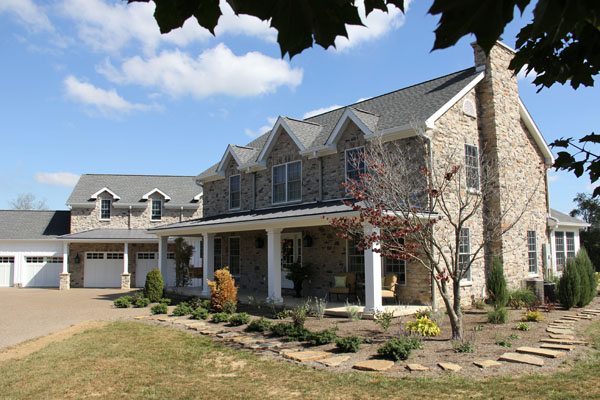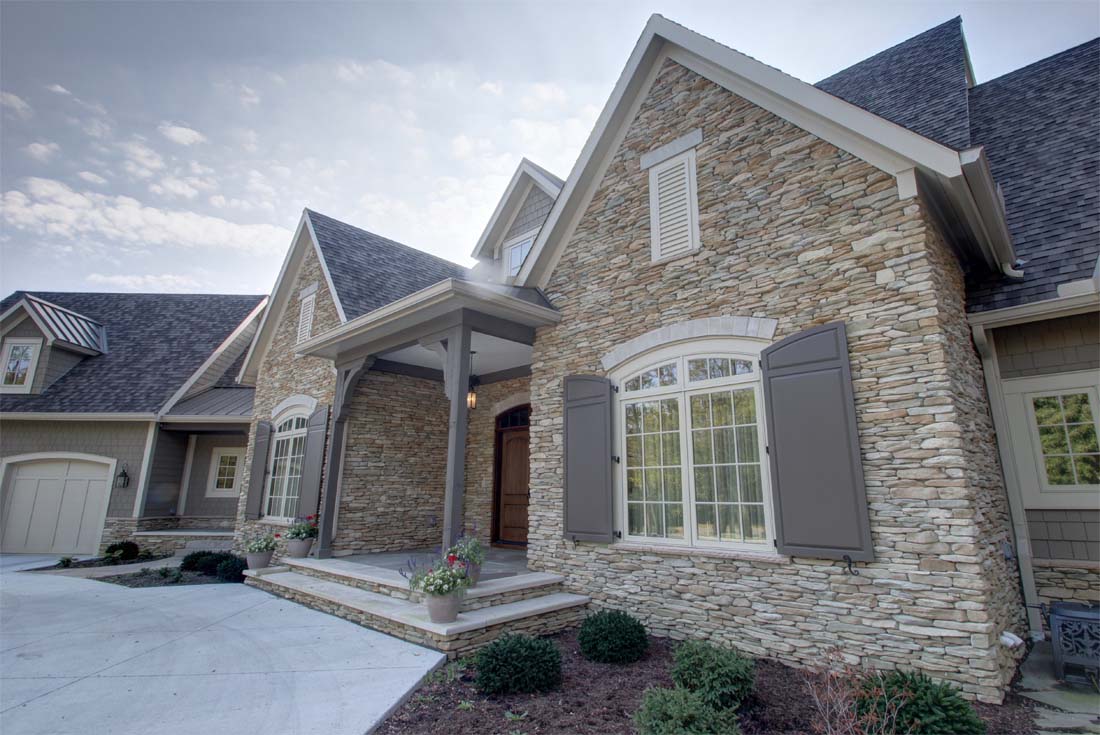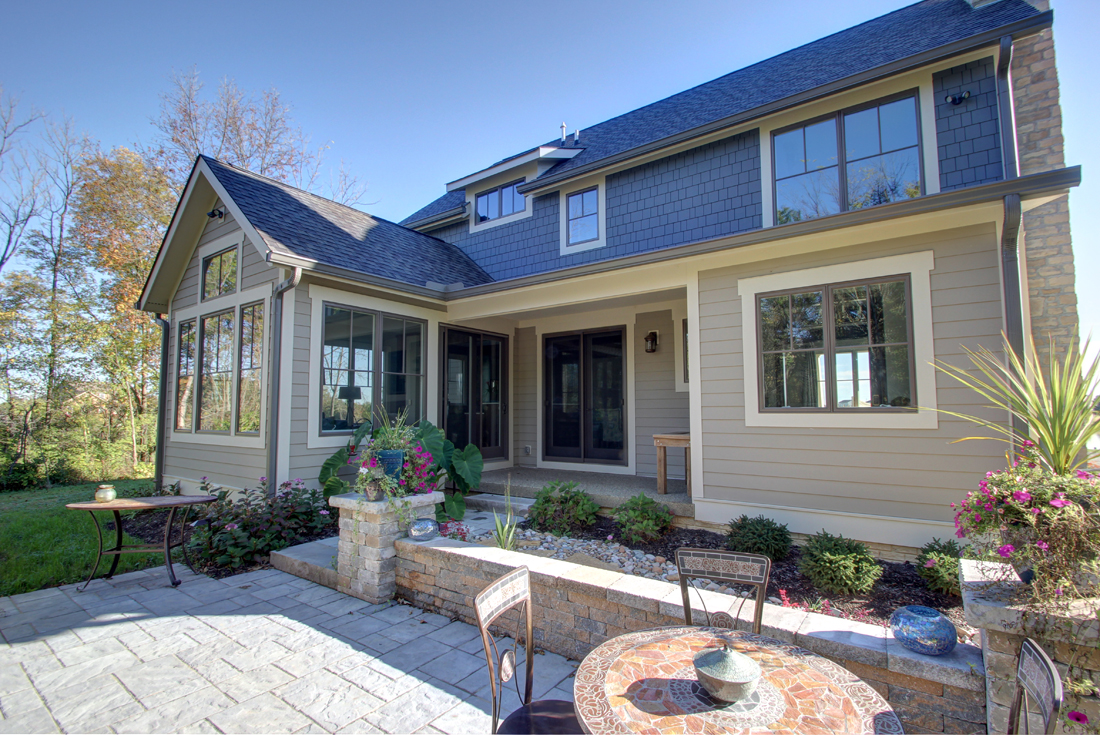
When To Use Fiber-Cement Siding and Cultured Stone (and When Not To)
Architects don’t want you putting fake stuff on the outside of your house – faux wood siding, faux stone, faux trim – just because it’s less expensive than the real thing.
We don’t like sacrificing aesthetics or authenticity, when the only benefit is cost savings.
There are trade-offs we’d rather you make when you’re trying to save money – house size for size’s sake, and artificially-complex design are at the top of my list.
Generally, I’m skeptical of “artificial” exterior materials – vinyl siding, fiber cement siding and cultured stone, vinyl windows, “thin brick”, aluminum trim, etc. because they’re seen as cheap(er) imitations that don’t compare favorably with the real thing.
From a strictly aesthetic point of view, some of those materials don’t quite look the part, and when used everywhere on a home, can lessen the overall appearance of quality. For authenticity, there’s nothing quite like real wood siding with a fresh coat of paint.
And yet, some artificial materials don’t require much maintenance, so they’ll look good much longer. And some of these materials are pretty convincing copies of their “real” counterparts, so why the big fuss?
In some cases, it’s tough to argue against using “artificial” finishes on a house.
One example is “cultured” stone, also known as “stucco” stone, “faux” stone, and “lick and stick” stone. Cultured stone is manufactured from the leftovers of the stone-quarrying process, so it’s actually partly made from “real” stone.

And when properly installed, it can be very hard to tell from the real thing. It’s less expensive to purchase and install than “real” stone, and weathers just about as well.
As a decorative exterior finish, cultured stone can be installed in areas where real stone is difficult or impossible to install because there’s no foundation to support the real stone (cultured stone doesn’t require a foundation for support).
That’s another thing I like about it.
But that’s also where the “big fuss” starts; you can cover a whole house with cultured stone – since it doesn’t need a foundation – but that doesn’t mean you should.
What you should do is use cultured stone as a secondary or accent material on a home, balancing it with the other exterior finishes to make the whole composition work well.
Many architecturally-controlled communities are cautious about approving fiber cement siding and cultured stone because it’s too easy to overuse or to use improperly. And like new paint on your home’s siding, once it’s up, it’s expensive to change.
Speaking of paint and siding, you have some “faux” options there, too, if you want longevity and low-maintenance, but whenever remotely possible, I prefer real wood. There are ways to minimize the maintenance of wood siding, which I was fortunate to have had on my last house.
I painted that house myself a few years ago – it was the second – and last – time I’ll ever paint this house, for a couple of reasons. First, it took me ten consecutive weekends. My son calls that a “fail” (I call it saving $10,000).
Second, the deep, 48” overhangs on my roof protect the wood siding and paint extremely well – the last paint job was 18 years ago. It won’t need paint again while I’m living here…that’s my definition of low-maintenance.
But “low-maintenance” – the primary reason most people want to use vinyl or aluminum siding – is more than just a quality of a building material; it can also be a function of the design of your house.
If my house had been designed without those overhangs, the rain and sun would likely have damaged the paint enough that I’d have had to paint it much more frequently.
There’s a fail for you.

You should want to use wood instead of plastic or aluminum siding for another reason – authenticity.
“Authentic” wood siding was created hundreds of years ago as a way to cover walls with narrow pieces of wood – pieces that could be easily cut from trees. They’re overlapped from the bottom up to shed rain, creating the look that’s so common on traditional American homes.
With metal and plastic we can imitate that “lapped” siding look, but why? Would early American carpenters have used lapped wood siding if they’d had plastic or metal sheets at hand?
Authenticity comes with a price – the possibility of maintenance – but if your home is properly designed, and the finishes are high-quality, that price might be worth it.
And maybe only paid once every 18 years.
Fortunately, in between “faux” wood siding and the real thing is something called “fiber-cement” siding. You may know it as “HardiePlank”, “WeatherBoards”, “WeatherSide”, and a few other trade names.
Fiber-cement siding is made from wood fibers and cement, which makes a very durable product, and when installed on a house, is an excellent likeness of the real thing.
You can purchase it pre-finished, or paint it yourself. Either way, a long, long time goes by before it needs paint again. And because it doesn’t shrink, swell, split, or twist, it’s as nearly a no-maintenance product as you can put on your home.
And since it installs one piece at a time, just like real wood lapped siding, the Architects are happy, too.
Cheaper than wood? Nope. Easier to install? Not really. But it’s “one and done” and that’s a usually a good swap for a little cash and sweat.



I saw an episode of The Old House and the contractor Richard’s house had burned down. When he rebuilt it, he used the cement boards rather than traditional wood as a way to help preserve it better should it happen again. Something else to consider.
Fiber Cement in fire zones is a best practice!
We are planning to use some Hardiplank to repair the house trim that the woodpeckers have drilled in their quest for the carpenter bee larvae.